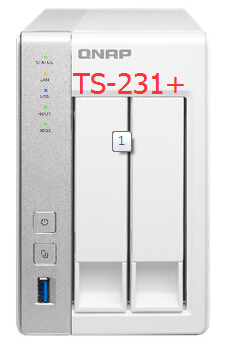Difference between revisions of "QNAP"
Jump to navigation
Jump to search
(adds info about backing up my laptop home directory from the QNAP) |
|||
| (4 intermediate revisions by the same user not shown) | |||
| Line 1: | Line 1: | ||
[[File:TS-231.jpg|right]] | [[File:TS-231.jpg|right]] | ||
| − | The | + | The QNAP NAS TS-231 forms the basis of our local network shares and backup |
2x 2TB Western Digital "Red" drives in RAID 1 configuration = 1.8 TB storage | 2x 2TB Western Digital "Red" drives in RAID 1 configuration = 1.8 TB storage | ||
| Line 7: | Line 7: | ||
locally on the network, it uses DHCP, with two ethernet nics (dual-homed) | locally on the network, it uses DHCP, with two ethernet nics (dual-homed) | ||
Access it via your network share (at 192.168.1.4 or 192.168.1.5) or externally at http://cloud.equality-tech.com | Access it via your network share (at 192.168.1.4 or 192.168.1.5) or externally at http://cloud.equality-tech.com | ||
| − | |||
| − | |||
| − | |||
| − | |||
| − | |||
| − | |||
| − | |||
| − | |||
| − | |||
| − | |||
| − | |||
| − | |||
| − | |||
| − | |||
| − | |||
== Operating System == | == Operating System == | ||
| Line 30: | Line 15: | ||
Under the covers, the QNAP is a Linux box, so if you want to reset someones password, you can just use the <code>passwd</code> command as usual. | Under the covers, the QNAP is a Linux box, so if you want to reset someones password, you can just use the <code>passwd</code> command as usual. | ||
| − | + | [[Category:Company]] [[Category:Cloud]] [[Category:Network]] [[Category:NAS]] [[Category:Storage]] [[Category:Server]] [[Category:Backups]] | |
| − | |||
| − | |||
| − | |||
| − | |||
| − | |||
| − | |||
| − | |||
| − | |||
| − | |||
| − | |||
| − | |||
| − | |||
| − | |||
| − | |||
| − | |||
| − | |||
| − | |||
| − | |||
| − | |||
| − | |||
| − | |||
| − | |||
| − | |||
| − | |||
| − | |||
| − | |||
| − | |||
| − | |||
| − | |||
| − | |||
| − | |||
| − | |||
| − | |||
| − | |||
| − | |||
| − | |||
| − | |||
| − | |||
| − | |||
| − | |||
| − | |||
| − | |||
| − | |||
| − | |||
| − | |||
| − | |||
| − | |||
| − | |||
| − | |||
| − | |||
| − | |||
| − | |||
| − | |||
| − | |||
| − | |||
| − | |||
| − | |||
| − | |||
| − | |||
| − | |||
| − | |||
| − | |||
| − | |||
| − | |||
| − | |||
| − | |||
| − | |||
| − | |||
| − | |||
| − | |||
| − | |||
| − | |||
| − | |||
| − | |||
| − | |||
| − | |||
| − | |||
| − | |||
| − | |||
| − | |||
| − | |||
| − | |||
| − | |||
| − | |||
| − | |||
| − | |||
| − | |||
| − | |||
| − | |||
| − | |||
| − | |||
| − | |||
| − | |||
| − | |||
| − | |||
| − | |||
| − | |||
| − | |||
| − | |||
| − | |||
| − | |||
| − | |||
| − | |||
| − | |||
| − | |||
| − | |||
| − | |||
| − | |||
| − | |||
| − | |||
| − | |||
| − | |||
| − | |||
| − | |||
| − | |||
| − | |||
| − | |||
| − | |||
| − | |||
| − | |||
| − | [[Category:Company]] | ||
| − | [[Category:Cloud]] | ||
| − | [[Category:Network]] | ||
| − | [[Category:NAS]] | ||
| − | [[Category:Storage]] | ||
| − | [[Category:Server]] | ||
| − | [[Category:Backups]] | ||
Revision as of 16:28, 7 March 2016
The QNAP NAS TS-231 forms the basis of our local network shares and backup
2x 2TB Western Digital "Red" drives in RAID 1 configuration = 1.8 TB storage
locally on the network, it uses DHCP, with two ethernet nics (dual-homed) Access it via your network share (at 192.168.1.4 or 192.168.1.5) or externally at http://cloud.equality-tech.com
Operating System[edit | edit source]
The QNAP uses an operating system called QTS (based on Linux and GPL) QTS 4.2.1
Administration[edit | edit source]
Under the covers, the QNAP is a Linux box, so if you want to reset someones password, you can just use the passwd command as usual.
